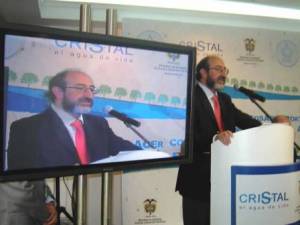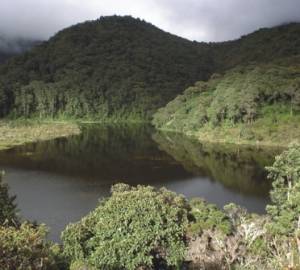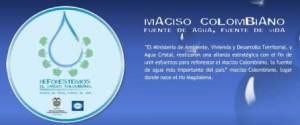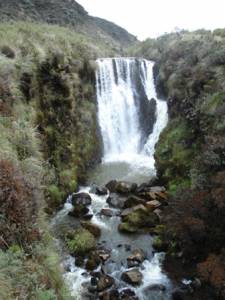« The Basics II, Foundations: Is a Constitutional Provision on the Environment Necessary? | Home | GEF Grants $4.8 Million to Help Costa Rica Upgrade Its National Parks »
Bottled Water and the Macizo Colombiano
By Keith R | June 28, 2007
Topics: Biodiversity, Conservation, Environmental Protection | No Comments »
 Are water bottlers seeking to become the champions of conservation and protecting freshwater sources?
Are water bottlers seeking to become the champions of conservation and protecting freshwater sources?
You have to wonder. At about the same time earlier this month that WWF was publicizing its freshwater protection partnership with Coca-Cola, owner of the Dasani brand of bottled water, Colombia’s Environment Minister, Juan Lozano Ramírez, was announcing an alliance with that country’s leading bottled water, Agua Cristal, to protect an area ultimately responsible for most of Colombia’s freshwater resources.
During May Lozano had stressed repeatedly the priority the Government placed on protecting an important eco-region known as “El Macizo Colombiano” and its place in the National Development Plan. He then opened June by holding a press conference to announce a “strategic alliance” with “Agua Cristal” (actually with the Colombian beverage conglomerate Postobón S.A., which owns the brand) to help reforest part of the Macizo Colombiano.
Lozano praised Postobón for pledging 10% of its income from Agua Cristal sales in the month of June 2007 to a project to recover the area in the Macizo around the Laguna de la Magdalena, where the Magdalena River originates. Under a banner proclaiming “Together we can do important things,” Lozano hailed the Agua Cristal pact as one for others in the private sector to emulate and stressed the importance of such government-private sector partnerships in recovering the Macizo.
If you’re not Colombian (and perhaps even if you are), you might be wondering what in the world is the Macizo Colombiano, why does it matter, and is the Agua Cristal partnership really such a big deal.
 The Macizo Colombiano
The Macizo Colombiano
The Macizo Colombiano — also known as the “Nudo de Almaguer y Estrella Fluvial Colombiana” — actually deserves the attention it’s getting. The large “eco-region” and hydrological system involves five departments (similar to states or provinces) — Valle, Huila, Cauca, Tolima, Nariño, Putumayo and Caquetá — and several national parks — Las Hermosas, Nevado del Huila, Puracé, Cueva de los Guácharos and Alto Fragua Indi-Wasi.
It serves as the ultimate source of freshwater and irrigation for some 70% of Colombia’s population, feeding some 65 lakes and four of Colombia’s most important rivers — the Magdalena, the Cauca, the Patía and the Caquetá.
The region contains extensive biodiversity (some 10% of the nation’s flora), some of it unique in the world. Parts of it have been classified by UNESCO as a World Biosphere Reserve.
Despite the fact that much of its territory has official protected status, the ecosystem is under pressure, particularly from deforestation for (often illegal) agricultural production. To strengthen protection of the area Colombia sought and received funds and technical assistance from the UN Development Programme (UNDP) and the Global Environment Facility (GEF) for a six-year program to create new protected areas within the region, improve protection of existing protected areas, change local production patterns that harm the ecosystem and get local communities involved in protection and conservation of the Macizo Colombiano.
 The Agua Cristal Deal
The Agua Cristal Deal
As mentioned above, Postobón agreed to provide 10% of its income derived from sales of the Agua Cristal brand during the month of June to be earmarked for the recovery of the area around Lake Magdalena. The recovery plan calls for the planting of 50,000 linear meters of native trees as “live fences,” the reforestation of 130 hectares, and the training of 500 families in sustainable production systems friendly to the conservation of the zone’s biodiversity.
I don’t have an ideological objection against Agua Cristal donating money to help recovery, conservation and protection of biodiversity in a major watershed (unless somebody can point me to a bad environmental record from Postobón, particularly regarding water issues). It’s good to see a major Colombian company helping the environment, and if it encourages others to step up to the plate, then all the better.
Of course, Postobón is probably not doing this out of pure altruism. I don’t know where they source the water that they use in Agua Crista, but it’s not a stretch to argue that they see it as in their long-term interests to protect the fountainhead of 70% of the country’s water supplies, and that it helps to associate their brand (marketed as “water of life”) that natural fountainhead. [Having that “money shot” of the Environment Minister next to the Agua Cristal logo certainly doesn’t hurt either!]
I wonder what the amount of the donation will be? An estimate was not offered when the deal was announced, and it’s difficult to guesstimate from the limited financial data Postobón publishes because they do not break down the data by brands. Also, it’s not clear whether the income involved is gross or net.
I also wonder why they chose a one short-term hit (a percentage of one month’s income), rather than a longer commitment. If, for example, they told consumers in steady media campaigns that the company would donate x% (probably lower than 10%) of every sale of Agua Cristal over a six- or twelve-month period to protect the Macizo, wouldn’t it both generate more money for the project and higher sustained sales for Agua Cristal?
— Keith R
 Desde el Ministerio de Ambiente, Vivienda y Desarrollo Territorial (MAVDT):
Desde el Ministerio de Ambiente, Vivienda y Desarrollo Territorial (MAVDT):
GOBIERNO INSISTE EN LA NECESIDAD DE PROTEGER EL MACIZO COLOMBIANO
“Es prioridad del Gobierno Nacional la conservación de esta reserva que involucra a cinco departamentos del país, y que fue considerada como prioridad dentro del Plan de Desarrollo aprobado recientemente en el Congreso” afirmó el ministro de Ambiente, Vivienda y Desarrollo Territorial, Juan Lozano Ramírez.
El Macizo Colombiano también conocido como “Nudo de Almaguer y Estrella Fluvial Colombiana”, está situado al oriente de Almaguer y al sur de Popayán (ambas en el departamento del Cauca) siendo el más importante de todos los centros hidrográficos del país, ya que en él tienen sus fuentes cuatro de los más notables ríos colombianos: el Magdalena, el Cauca, el Patía y el Caquetá.
Este complejo hidrológico abastece de agua dulce y riego al 70% de la población colombiana, convirtiéndose así en parte esencial del aparato productivo de la nación.
Gran parte del equilibrio ecológico y climático del país se debe a que en el macizo se originan más de 65 cuerpos lagunares y más de 15 páramos (257.000 con vegetación única en el mundo) junto a extensas áreas de bosque altoandino.
Sin embargo factores como la deforestación; representado con la sustitución del bosque nativo por cultivos agrícolas e ilícitos, sumado a la existencia de cultivos de amapola en áreas bosque-andino tienen en riesgo la vida de una de las principales fuentes hídricas del país.
Paralelamente el inadecuado empleo de los sistemas de producción y la expansión de la colonización en 17 puntas es un motivo de preocupación, pues la conversión de paramos en zonas de producción agropecuaria ha llegado a abarcar 50.000 hectáreas, fragmentando o destruyendo totalmente dichos ecosistemas cuya vegetación es única en el mundo.
El área de influencia del Macizo Colombiano se extiende por el norte hasta el páramo de Barragán, al nororiente limita con el piedemonte de la cordillera Central, hacia el sur se conecta con la cordillera Oriental por el valle del río Magdalena, al suroriente limita con el piedemonte de la cordillera Oriental (Macizo de Garzón) y hacia el suroccidente limita con el volcán Galeras.
Los límites norte y sur del núcleo del Macizo están definidos por lineamientos tectónicos de dirección aproximada este-oeste, cuyas expresiones topográficas son los cañones de los ríos Cauca-Piedra.
El jefe de la cartera ambiental dijo “que la conservación de esta bio-región será tema prioritario dentro de los planeas que tiene el Gobierno Nacional para el inmediato futuro. Apoyo para los programas de conservación y protección de los recursos naturales y una acción integral para la recuperación del río Magdalena, en la que están comprometidas todas las Corporaciones Autónomas Regionales”.
El Macizo Colombiano presenta una gran variedad de climas que va desde el cálido seco hasta el nival (nieve). Las zonas de mayores lluvias se localizan hacia el suroriente, mientras que las zonas con menor precipitación se encuentran hacia el oriente.
Presenta un amplio rango de temperaturas que oscila entre 0ºC, a alturas superiores a los 5.000 metros sobre el nivel del mar, y máximas de 28ºC, en las partes bajas del valle interandino del Alto Magdalena.
En esta zona el comportamiento hidrológico de las cuencas de los ríos Magdalena y Cauca, pueden considerarse de régimen bimodal, o sea que tiene dos períodos húmedos y dos secos, siendo el período de abril a junio más acentuado que el de octubre a noviembre.
Es un sitio de gran biodiversidad ecológica donde tiene origen las cordilleras Central y Oriental y donde confluyen los ecosistemas Andino, Amazónico y Pacífico, albergando el 10% de la flora nacional.
Posee un valioso patrimonio étnico y cultural, caracterizado por la presencia de 7 grupos étnicos que suman cerca de 200.000 habitantes y es considerado por la Unesco como una de las Reservas Mundiales de la Biosfera.
“Velando por su conservación podemos garantizar el bienestar y sostenibilidad de las estructuras sociales y naturales. La poca inversión en esta parte de la geografía nacional es histórica, de modo que se deben asegurar fuentes ciertas de recursos para que en lo que queda de esta administración, y en las siguientes, la carta de navegación sobre este particular no quede en letra muerta”, puntualizó Ramírez Lozano.
Tags: Agua Cristal, agua dulce, Alto Fragua Indi-Wasi, bosque altoandino, bottled water, Caquetá, Cauca, Colombia, cordillera Central, cordillera Oriental, Cueva de los Guácharos, deforestación, deforestation, freshwater resources, GEF, Huila, Juan Lozano, Laguna de la Magdalena, Las Hermosas, Macizo Colombiano, MAVDT, Nariño, Nevado del Huila, PNUD, Postobón S.A., Puracé, Putumayo, Reservas Mundiales de la Biosfera, rio Caquetá, rio Cauca, rio Magdalena, rio Patía, Tolima, UNDP, UNESCO, Valle, volcán Galeras, World Biosphere Reserve


